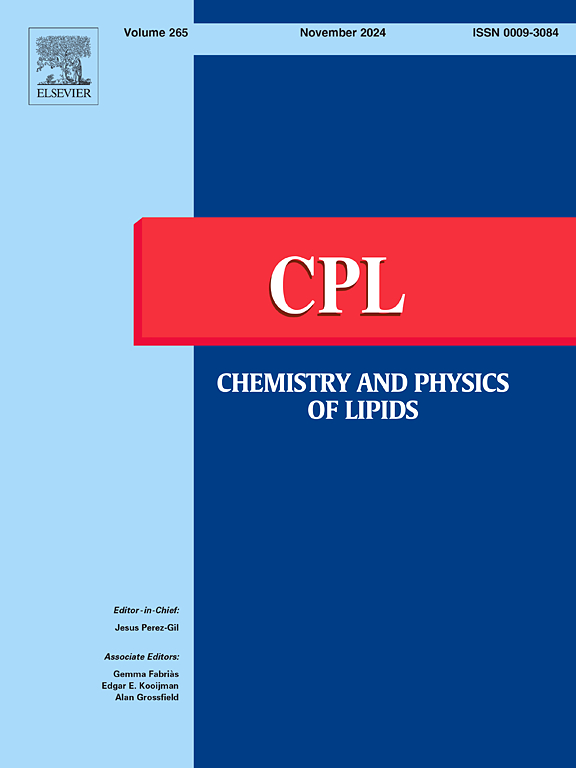Cholesterol´s role in membrane organization and nicotinic acetylcholine receptor function: Implications for aging and Alzheimer's disease
IF 2.8
3区 生物学
Q2 BIOCHEMISTRY & MOLECULAR BIOLOGY
引用次数: 0
Abstract
Biological membranes are complex entities composed of various molecules exhibiting lateral and transbilayer lipid asymmetries, along with a selective spatial distribution of different membrane proteins. This dynamic orchestration is crucial for proper physiological functions, undergoes changes with aging, and is disturbed in several neurological disorders. In this review, we analyze the impact of disruption in this equilibrium on physiological aging and the onset of pathological conditions. Alzheimer´s disease (AD) is a multifactorial neurodegenerative disorder in the elderly, characterized by the increased presence of the Aβ peptide, which supports the amyloid hypothesis of the disease. However, AD also involves a progressive loss of cholinergic innervation, leading to the cholinergic hypothesis of the disease. Nicotinic acetylcholine receptors (nAChRs) are transmembrane proteins, and Aβ peptides, their oligomeric and fibrillar species, which increase in hydrophobicity as they develop, interact with membranes. Therefore, a membrane hypothesis of the disease emerges as a bridge between the other two. Here, we discuss the impact of the membrane environment, through direct or indirect mechanisms, on cholinergic signaling and Aβ formation and subsequent incorporation into the membrane, with a special focus on the crucial role of cholesterol in these processes.
胆固醇在膜组织和尼古丁乙酰胆碱受体功能中的作用:对衰老和阿尔茨海默病的影响。
生物膜是由各种分子组成的复杂实体,具有横向和跨双分子层脂质不对称性,以及不同膜蛋白的选择性空间分布。这种动态的协调对正常的生理功能至关重要,随着年龄的增长而发生变化,并在一些神经系统疾病中受到干扰。在这篇综述中,我们分析了这种平衡的破坏对生理衰老和病理条件发作的影响。阿尔茨海默病(AD)是一种多因素的老年人神经退行性疾病,其特征是a β肽的存在增加,这支持了该疾病的淀粉样蛋白假说。然而,阿尔茨海默病也涉及胆碱能神经支配的进行性丧失,导致疾病的胆碱能假说。烟碱乙酰胆碱受体(nAChRs)是跨膜蛋白和Aβ肽,它们的寡聚体和纤维状物种,随着它们的发育,疏水性增加,与膜相互作用。因此,该疾病的膜假说成为其他两种假说之间的桥梁。在这里,我们讨论了膜环境的影响,通过直接或间接的机制,对胆碱能信号和a β的形成和随后并入膜,特别关注胆固醇在这些过程中的关键作用。
本文章由计算机程序翻译,如有差异,请以英文原文为准。
求助全文
约1分钟内获得全文
求助全文
来源期刊

Chemistry and Physics of Lipids
生物-生化与分子生物学
CiteScore
7.60
自引率
2.90%
发文量
50
审稿时长
40 days
期刊介绍:
Chemistry and Physics of Lipids publishes research papers and review articles on chemical and physical aspects of lipids with primary emphasis on the relationship of these properties to biological functions and to biomedical applications.
Accordingly, the journal covers: advances in synthetic and analytical lipid methodology; mass-spectrometry of lipids; chemical and physical characterisation of isolated structures; thermodynamics, phase behaviour, topology and dynamics of lipid assemblies; physicochemical studies into lipid-lipid and lipid-protein interactions in lipoproteins and in natural and model membranes; movement of lipids within, across and between membranes; intracellular lipid transfer; structure-function relationships and the nature of lipid-derived second messengers; chemical, physical and functional alterations of lipids induced by free radicals; enzymatic and non-enzymatic mechanisms of lipid peroxidation in cells, tissues, biofluids; oxidative lipidomics; and the role of lipids in the regulation of membrane-dependent biological processes.
 求助内容:
求助内容: 应助结果提醒方式:
应助结果提醒方式:


